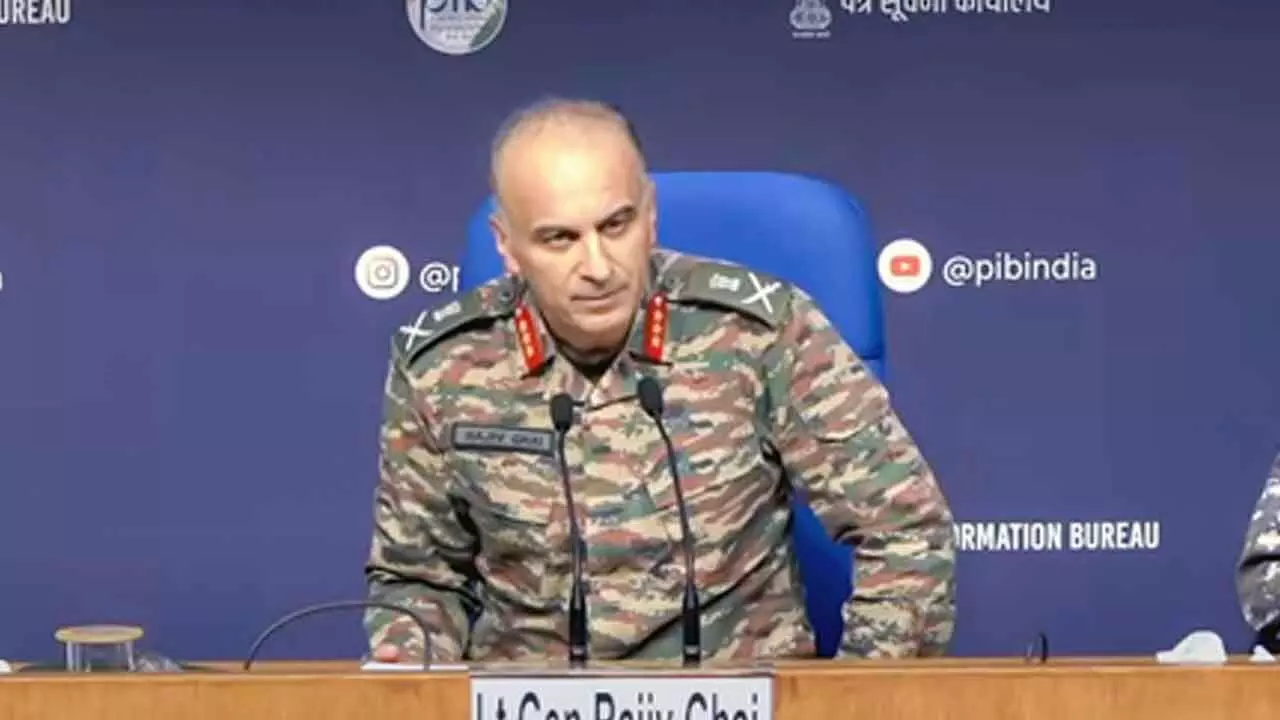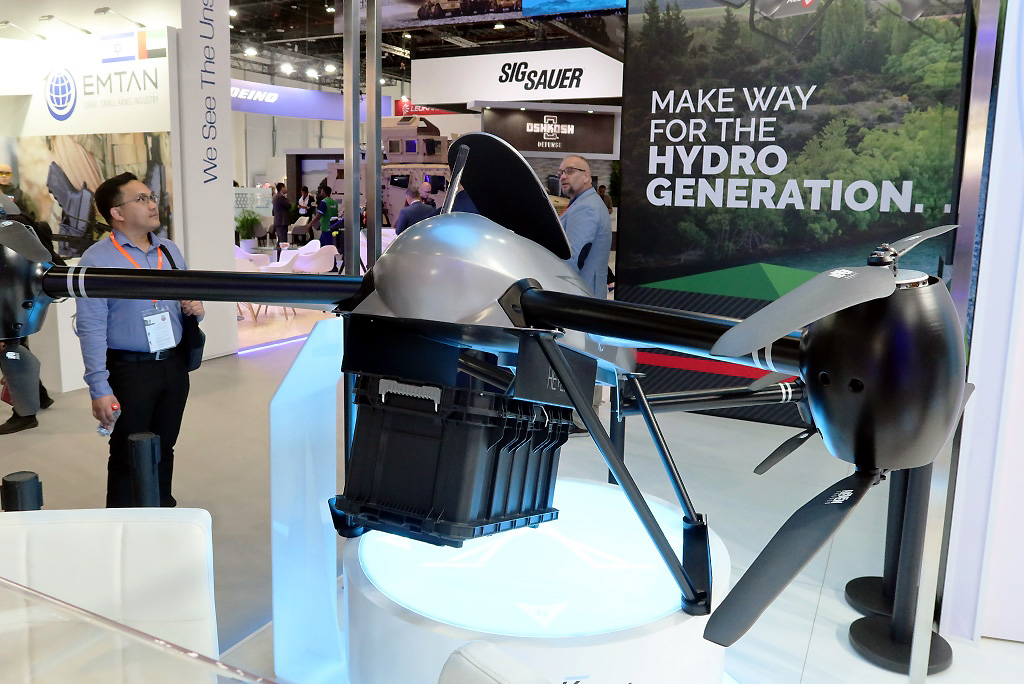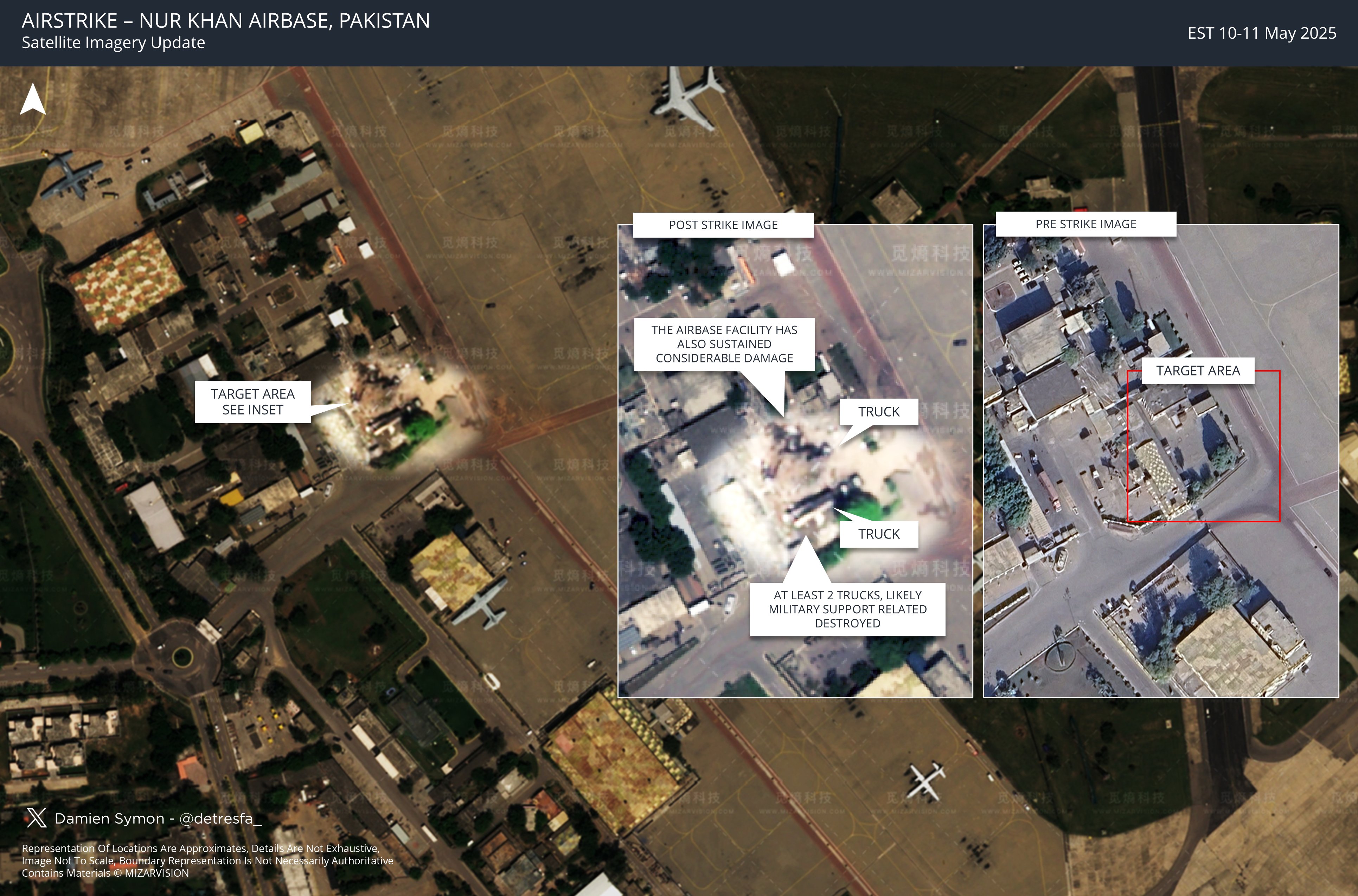SOURCE: AFI


In a precision strike showcasing India’s growing stand-off strike capabilities, the Indian Air Force (IAF) has reportedly destroyed a newly established hangar hosting multiple Chinese-origin Wing Loong-2 (WL-2) Unmanned Combat Aerial Vehicles (UCAVs) at Pakistan Air Force (PAF) Base Sukkur. The strike was carried out using Rampage air-launched ballistic missiles (ALBMs) launched from Jaguar Darin-II deep penetration strike aircraft.
The target facility, which had recently been set up with Chinese assistance, was believed to be intended for offensive drone operations against Indian Army’s strike corps formations along the western front. Sources indicate that the strike resulted in the complete destruction of the hangar, with the roof collapsing inward, likely neutralizing all UCAVs present within.
Continue readingSOURCE: AFI


In a stunning display of aerial dominance, the Indian Air Force (IAF) has released satellite imagery showcasing the precision targeting of critical Pakistani Air Force (PAF) infrastructure. The images reveal the destruction of at least three AN/TPS-77 radars—advanced systems recently acquired by Pakistan from Lockheed Martin—along with main radar installations at seven PAF airbases. This operation has effectively blinded a significant portion of Pakistan’s air defense network, underscoring India’s strategic superiority in the region.
The AN/TPS-77, a mobile, long-range air surveillance radar, is a cornerstone of modern air defense, capable of detecting aircraft at extended ranges. Pakistan’s recent acquisition of these systems was seen as a bid to bolster its early warning capabilities. However, the IAF’s strikes have rendered at least three of these radars inoperable. Satellite images of the Ijwala Air Defence Radar and Chunian Air Defence Radar explicitly show the “before” and “after” states, with the radar sites marked as “radar head destroyed” and “radar site destroyed” post-strike. The precision of these attacks highlights the IAF’s ability to neutralize high-value targets with surgical accuracy.
Continue readingSOURCE: PTI


Scientists at the Defence Research and Development Organisation (DRDO) are working on a humanoid robot that can be part of frontline military mission, an official said on Saturday. The Research and Development Establishment (Engineers), a key lab under the DRDO, is developing a machine that can carry out complex tasks under direct human command, aiming to reduce troop exposure in high-risk environments, the official said.
Talking to PTI, S E Talole, group director at the Centre for Systems and Technologies for Advanced Robotics within the R&DE (Engineers), said the team has been engaged in the project for four years.
Continue readingSOURCE: PTI
)

Pakistan realised that India meant business after its eight air bases were destroyed, and “sued for peace” by seeking a cessation of hostilities, government sources said on Sunday. There was no need for a third-party intervention and, in fact, US Secretary of State Marco Rubio called External Affairs Minister S Jaishankar to convey that the Pakistanis got the message after being hammered by Indian missiles, they said.
The comments dilute US President Donald Trump’s claim that American mediation brought about peace, said the sources, pointing out that Trump is given to hyperbole.
Continue readingSOURCE: IANS


India’s air defence system, in the wake of fierce India-Pakistan showdown in the skies, has come as the shining example of the country’s military might in bringing enemies to its knees and is also garnering the international spotlight, with many defence experts weighing in their praise.
Noted defence analyst John Spencer, taking note of India’s modern air defence said that the country not only defended its own airspace but also pierced through Chinese-made systems fielded by Pakistan, with ease and precision.
Continue readingSOURCE: IANS


Pakistan Army lost close to 35-40 of its personnel between May 7-10, when India launched retaliatory counterstrikes responding to its aggression, the Director General of Military Operations (DGMO) Lt Gen Rajiv Ghai said in a special press briefing on Sunday.
He also said that the Operation Sindoor was conceptualised with a clear military aim to punish the perpetrators and planners of terror and to destroy their terror infrastructure.
Continue readingSOURCE: IANS


Indian Navy, for the first time on Sunday, revealed the role naval forces played during Operation Sindoor in response to the Pahalgam terror attack in which 26 civilians, mostly tourists, were killed. It said that the Navy’s deployment in the Arabian Sea during Operation Sindoor virtually forced the Pakistan Navy to remain in the harbour or near the coast.
Vice Admiral A.N. Pramod, Director General of Naval Operations, stated that the Indian Navy was fully prepared within 96 hours of the terror attack to execute strikes against Pakistan’s military installations during Operation Sindoor.
Continue readingSOURCE: IANS


In a massive diplomatic and military rebuke, India has exposed Pakistan’s duplicity after it violated a ceasefire agreement that was initiated by its own military leadership. The understanding, meant to end four days of intense cross-border hostilities, was proposed by the Pakistani Director General of Military Operations (DGMO) during a direct hotline call with his Indian counterpart.
Lieutenant General Rajiv Ghai, India’s DGMO, revealed that the proposal to halt hostilities came directly from Pakistan on May 10. “My communication with the Pak DGMO was conducted at 15:35 hours yesterday (Saturday) and resulted in cessation of cross-border firing and air intrusions by either side with effect from 17:00 hrs, 10th of May, after he proposed that we cease hostilities,” Lt Gen Ghai stated during a press briefing on Sunday.
Continue readingSOURCE: PTI
)

The government on Sunday dismissed as “false” social media reports about explosions in Udhampur and drones being spotted in certain areas of Jammu and Kashmir. “Claims of heavy explosions in Udhampur are circulating on social media. The claim is FALSE. There have been no explosions in Udhampur,” the Press Information Bureau’s (PIB) Fact Check Unit said in a post on X.
It said these rumours were being spread to create panic and urged people to rely only on official government sources for accurate information. The PIB’s Fact Check Unit also dubbed as “fake” claims on social media that drones had been spotted in certain areas of Jammu and Kashmir.”This claim is fake. There is no drone activity in Jammu and Kashmir,” it said on X.Social media has been awash with various claims regarding the recent military conflict between India and Pakistan in wake of the April 22 terror attack in Pahalgam.
Continue readingSOURCE: IDRW.ORG


As the recent India-Pakistan clash has spotlighted advanced air defence systems like the Hardkill, a lesser-known but equally formidable Indian innovation is quietly reshaping the battlefield. The Drone-Detect, Deter, and Destroy (D4) system, developed indigenously by the Defence Research and Development Organisation (DRDO), has emerged as a nightmare for Pakistan’s drone incursions, particularly its Turkish-supplied unmanned aerial vehicles (UAVs). Successfully inducted into all three Indian armed services, this ground-based, nearly invisible system is neutralizing Pakistan’s aerial threats with non-kinetic precision, cementing India’s technological edge in modern warfare.
Pakistan’s relentless use of drones along India’s western border, often deploying Turkish-made UAVs, has aimed to probe Indian air defences, deliver payloads, and degrade military resources. However, the DRDO’s D4 system has proven to be an impenetrable barrier, akin to Israel’s famed Iron Dome, which intercepts rocket attacks from Hamas and Houthis. Unlike traditional air defence systems that rely on kinetic interception, the D4 employs sophisticated non-kinetic methods to detect, disrupt, and destroy enemy drones, rendering Pakistan’s aerial incursions largely ineffective.
Continue readingSOURCE: IDRW.ORG


In a significant leap for India’s defence and aerospace sector, Paras Defence and Space Technologies Ltd. has announced that India’s first locally-manufactured hydrogen-powered drones are ready for deployment. This milestone follows the company’s strategic joint venture (JV) with Israel’s HevenDrones, a subsidiary of the US-based Heven, known for its expertise in autonomous, hydrogen-powered, mission-specific unmanned aerial vehicles (UAVs). The announcement, made by Munjal Sharad Shah, Managing Director of Paras Defence, underscores India’s growing capabilities in cutting-edge defence technologies and aligns with the ‘Make in India’ initiative.
In a significant leap for India’s defence and aerospace sector, Paras Defence and Space Technologies Ltd. has announced that India’s first locally-manufactured hydrogen-powered drones are ready for deployment. This milestone follows the company’s strategic joint venture (JV) with Israel’s HevenDrones, a subsidiary of the US-based Heven, known for its expertise in autonomous, hydrogen-powered, mission-specific unmanned aerial vehicles (UAVs). The announcement, made by Munjal Sharad Shah, Managing Director of Paras Defence, underscores India’s growing capabilities in cutting-edge defence technologies and aligns with the ‘Make in India’ initiative.
Continue readingSOURCE: AFI


On May 10, 2025, Pakistan’s Bholari Air Base, located near Hyderabad in Sindh province, came under a sudden and intense attack, reportedly carried out by Indian forces, according to sources on the Pakistani side. The assault, which targeted a hangar at the air base, resulted in significant casualties, injuries, and damage to critical military assets, further escalating the ongoing India-Pakistan conflict sparked by India’s Operation Sindoor. The attack has drawn sharp condemnation from Pakistani officials, who claim it occurred just before a proposed ceasefire, raising questions about the timing and intent of the strike.
According to reports from Pakistani sources, including posts on X and statements attributed to former Pakistani President Arif Alvi, the attack unfolded with devastating precision. At the time of the strike, 52 personnel were working in and around a hangar at Bholari Air Base, a key facility under the Pakistan Air Force’s Southern Air Command. Of these, 40 personnel were inside the hangar, while 12 were outside. Without warning, an Indian missile struck the hangar, killing five personnel on the spot, including Squadron Leader Usman Yousaf, a respected officer in the Pakistan Air Force. The blast left the remaining personnel injured, many of whom are reportedly still buried under the rubble.
Continue readingSOURCE: AFI


On May 11, 2025, satellite imagery released by Chinese firm MIZARVISION provided stark evidence of the significant damage inflicted on Pakistan’s Nur Khan Airbase following a precision airstrike by the Indian Air Force. The imagery, which includes both pre- and post-strike visuals, highlights the targeted destruction of critical infrastructure and ground support vehicles, underscoring the effectiveness of India’s military operation.
The satellite images reveal a focused strike on a specific area of the airbase, marked as the “Target Area” in the imagery. Post-strike visuals show considerable damage to the airbase facility, with structures heavily impacted and debris scattered across the site. Notably, at least two trucks—likely military support vehicles—were destroyed, as indicated in the detailed inset images. The precision of the strike suggests a deliberate effort to cripple the airbase’s operational capabilities, targeting key infrastructure and vehicles essential for ground support.
Continue readingSOURCE: AFI


A German-manufactured Luna Unmanned Aerial Vehicle (UAV) has reportedly crashed in Pakistan, according to footage and posts circulating on X from Pakistani accounts. The Luna UAV, a lightweight reconnaissance and surveillance drone, is operated by both the Pakistan Army and Navy for intelligence, surveillance, and reconnaissance (ISR) missions. The incident has sparked speculation about the cause of the crash and its implications for Pakistan’s UAV program, though official confirmation from Pakistani authorities remains absent.
The Luna UAV, developed by EMT Penzberg in Germany, is a tactical unmanned aircraft system (TUAS) designed for medium-range reconnaissance. With a takeoff weight of approximately 110 kg, it is constructed from carbon fiber reinforced plastics, offering low acoustic, thermal, and radar signatures. The drone is equipped with advanced payloads, including synthetic aperture radar (SAR), signals intelligence (SIGINT), and electro-optical/infrared (EO/IR) sensors, and boasts an endurance of over 12 hours with a range exceeding 100 kilometers. Its ability to glide silently without engine power enhances its stealth capabilities, making it ideal for covert surveillance missions. The Pakistan Navy has utilized the Luna NG (Next Generation) variant since its induction in 2020 for coastal and maritime surveillance, while the Army has employed earlier models like the Luna X-2000 for tactical operations since the late 2000s.
Continue readingSOURCE: AFI


In a surprising turn of events, just weeks after a high-profile social media campaign highlighting the operationalization of Saidu Sharif Airbase in Swat to bolster Pakistan Air Force (PAF) operations and mobilization, a new Notice to Airmen (NOTAM) has revealed that the airbase’s runway will be offline for construction works through May 2025.
The NOTAM, issued under the identifier C0830/25, states that the runway (RWY-05/23) at Saidu Sharif Airbase—designated as OPSS—will not be available due to ongoing runway extension and upgradation work in progress (WIP). The closure began on April 9, 2025, and is scheduled to continue until May 23, 2025, impacting operations for over a month.
Continue reading